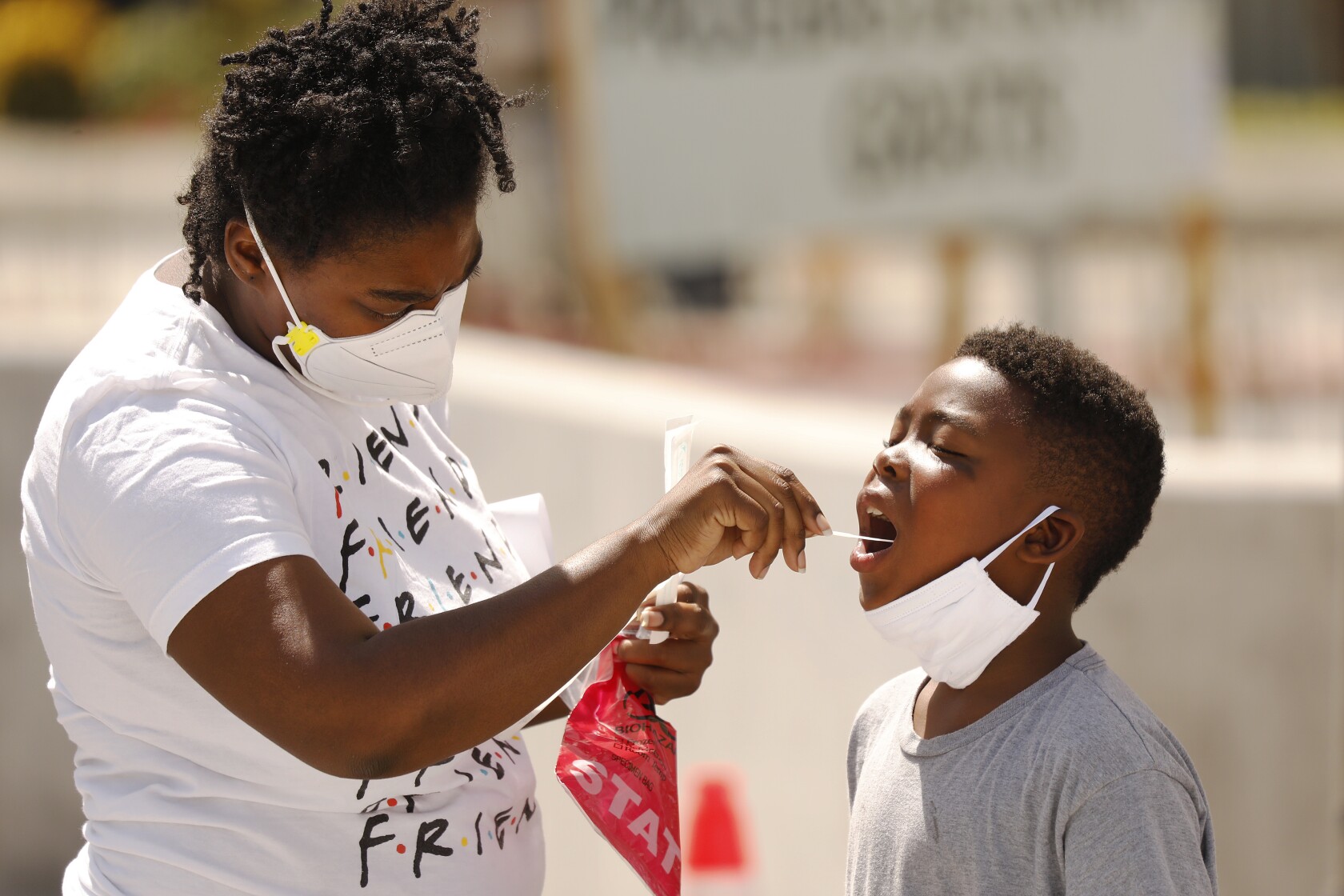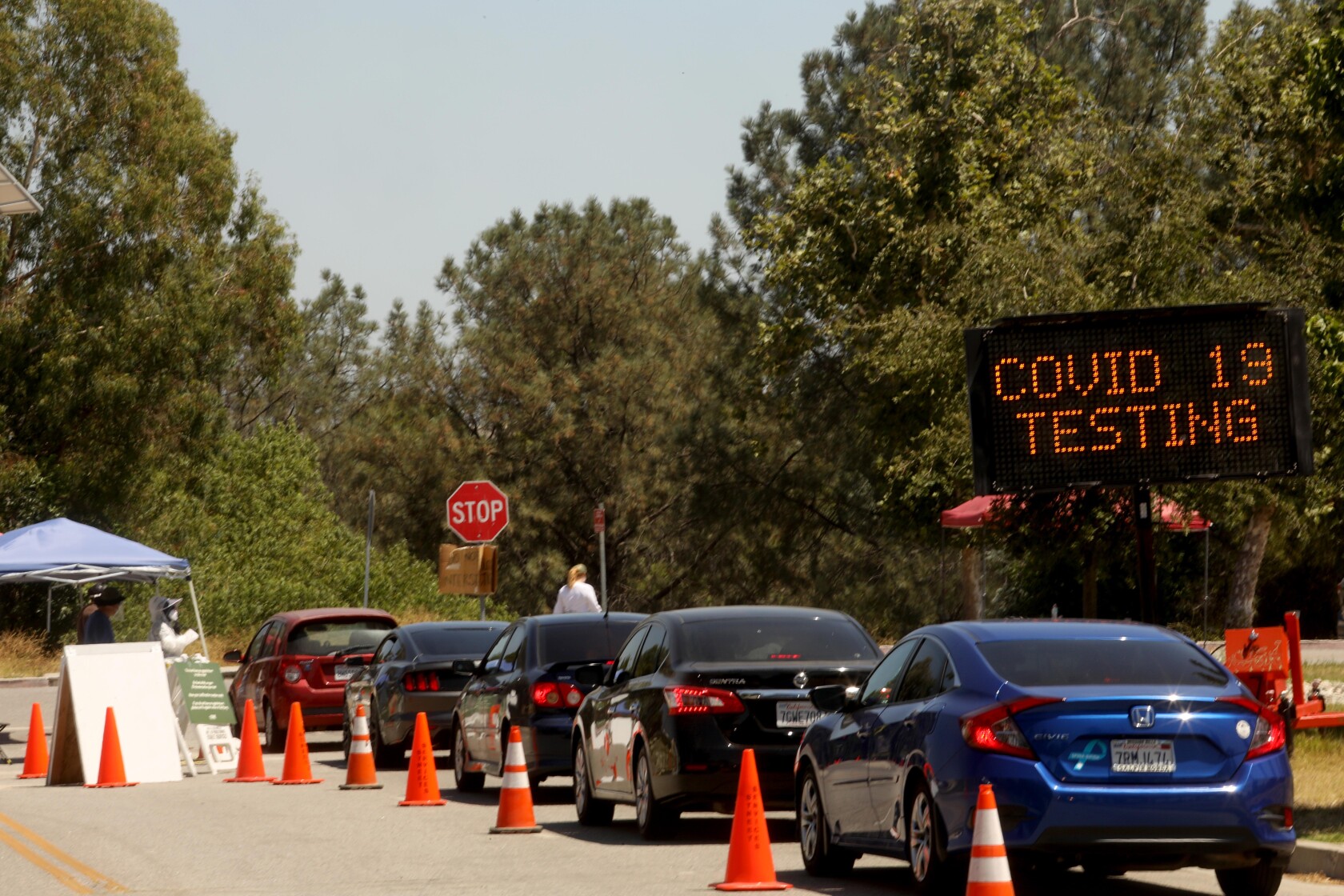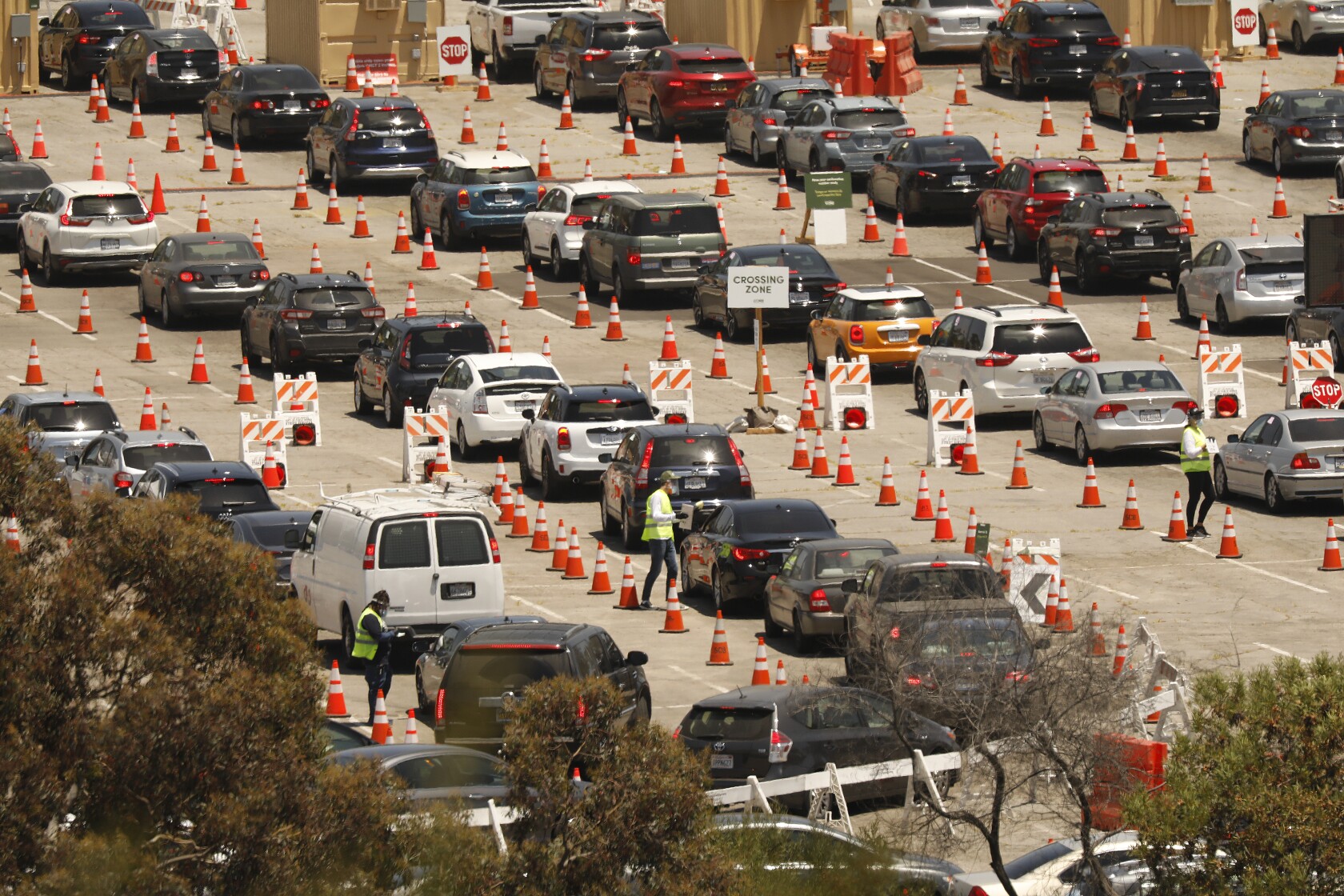A month into his stay-at-home order and under pressure to lift restrictions, Gov. Gavin Newsom drew a line in the sand: In order to safely reopen and suppress the coronavirus, California needed to be able to test everyone with COVID-19 symptoms and trace the contacts of confirmed cases.
“The most important framework is our capacity to expand our testing to appropriately address the tracing and tracking of individuals, the isolation and the quarantine of individuals,” the governor said of his thresholds for reopening at an April 14 news conference.
But three weeks later, Newsom began reopening businesses before meeting his own benchmarks.
Now, the governor has once again ordered closures as California surpasses 350,000 COVID-19 cases. Hospitalizations have more than doubled and deaths have nearly tripled since Newsom launched the reopening on May 8. Many Californians are still struggling to get tested amid new shortages and growing demand.



1/12
Cynthia Leonard helps her son Messi McDaniel, 6, with an oral swab test outside the Charles R. Drew University of Medicine and Science in South Los Angeles.
(Al Seib/Los Angeles Times)
2/12
A worker registers a driver who is celebrating a birthday with a test for coronavirus infection at the Hansen Dam Recreation Area testing site.
(Genaro Molina/Los Angeles Times)
3/12
Cars wait in line at the free COVID-19 testing site at the Hansen Dam Recreation Area in Sylmar.
(Genaro Molina/Los Angeles Times)
4/12
A worker checks the coronavirus test registration of a driver at the Hansen Dam site.
(Genaro Molina/Los Angeles Times)
5/12
Motorists line up for COVID-19 testing at Dodger Stadium.
(Al Seib/Los Angeles Times)
6/12
Mari Cruz takes a COVID-19 test from Tiffany Im at the Orange County Great Park in Irvine.
(Allen J. Schaben/Los Angeles Times)
7/12
Hundreds of motorists wait for COVID-19 tests in the Dodger Stadium parking lot.
(Brian van der Brug/Los Angeles Times)
8/12
Maritza Perez, a registered nurse, puts on her personal protective equipment before administering COVID tests to some 50 to 65 patients at AltaMed Health Services in Anaheim.
(Allen J. Schaben/Los Angeles Times)
9/12
Wilma Thomas, a registered nurse, left, and Viviana Robles, a licensed practical nurse, stand near a mister on a hot day of coronavirus testing at AltaMed Health Services in Anaheim.
(Allen J. Schaben/Los Angeles Times)
10/12
Gregory Williams helps daughter Althea, 7, with an oral swab COVID-19 test at Charles R. Drew University of Medicine and Science in South L.A. His wife, Zulema Cuevas, holds their 2-year-old.
(Al Seib/Los Angeles Times)
11/12
Walk-ins wait at the Charles R. Drew University of Medicine and Science testing site.
(Al Seib/Los Angeles Times)
12/12
Dalton Caputo delivers his family’s test samples at the Charles R. Drew site.
(Al Seib/Los Angeles Times)
The testing delays and inadequate resources for contact tracing make it impossible to halt spread of the virus, something that Newsom and state health officials had said the state needed to be prepared to do before opening up.
California Health and Human Services Secretary Dr. Mark Ghaly defended the governor’s approach in an interview with The Times, noting that the fluid nature of the virus requires the state to constantly learn and adapt. He said counties attested to meeting the state’s requirements before they were allowed to move forward and he felt confident at the time that California was adequately testing symptomatic patients.
But in documentation submitted to the state attesting to their readiness for reopening, 17 counties wrote that they did not meet requirements for available, trained contact tracing staff and more than two dozen hadn’t hit targets for daily testing thresholds when they applied. Many of the counties said they intended to train more workers to investigate cases, or that they would have the capacity to boost testing, and Ghaly said those plans were sufficient for the state to allow them to reopen.
Those decisions are coming under scrutiny as the coronavirus is again surging unchecked.
An analysis by the Harvard Global Health Institute suggests California is conducting less than half the daily tests necessary to mitigate the virus and far fewer than needed to stop the spread, while states such as New York show greater success with testing. California’s testing rate was even lower when Newsom allowed counties to begin opening bars and gyms on June 12.
“California has kept the lid on the pot, but that’s not good enough,” said Thomas Tsai, an assistant professor in the Department of Health Policy and Management at the Harvard T.H. Chan School of Public Health. “The goal is to turn the temperature down or get the pot off the stove.”
As efforts across the country to fight the deadly virus have been politicized, Newsom’s early assertion that the state’s reopening would be guided by science and health, not politics, was regarded as a gold standard by public health experts. Tsai and other researchers say widespread testing, tracking confirmed cases and isolating anyone who may have been exposed are among the only ways to stop the spread of the virus, absent a vaccine.
Experts hailed California’s March 19 stay-at-home order and credited Newsom’s decision-making in the early stages of the crisis, saying that his actions bought time for the healthcare system to prepare and prevented cases from overwhelming hospitals.
With businesses itching to reopen, Newsom called a news conference on April 14 and disclosed the parameters that he and top health officials had been privately using to determine when it was safe to return the state to some sense of normalcy.
In a document outlining the state’s six indicators for monitoring the stay-at-home order, officials posed key questions to be answered before reopening : “How prepared is our state to test everyone who is symptomatic?” and “do we have the ability to identify contacts of those who are positive to reduce further transmission?”
The stories shaping California
Get up to speed with our Essential California newsletter, sent six days a week.
You may occasionally receive promotional content from the Los Angeles Times.
The governor introduced a four-phase reopening plan two weeks later. A document provided by the administration on April 28 again described the thresholds as the “ability to test, contact trace, isolate, and support the exposed.” Among the key measures to move into Stage 2 were “sufficient testing capacity to meet demand” and “contact tracing capacity statewide.”
When the governor announced the imminent reopening of businesses and beginning of Stage 2 in early May, he called it a “very positive sign” that happened for only one reason: “Data says it can happen.”
By that time, Newsom faced pressures from all sides. While some local public health officials wanted the governor to keep the stay-at-home order in place, frustrated residents and a few local governments openly defied his restrictions. More than 3.5 million Californians had filed for unemployment benefits at that point and businesses across the state worried they couldn’t survive a continued shutdown.
The governor’s plan also included something the state described as a variance process that would allow counties to reopen more quickly if they met a series of benchmarks to show they were capable of containing the spread of the coronavirus.
Among the criteria to be met was a requirement that counties ensure at least 15 staff members per 100,000 residents were trained and available to conduct contact tracing, which 17 counties said they had not yet met and detailed plans to increase staffing over the coming weeks or months.
Another requirement noted that counties must have the capacity to test a daily minimum of 1.5 residents for every 1,000. Though more than two dozen counties had not reached the daily testing threshold when they submitted their forms to reopen, they still met the state’s standard because they explained how they could scale up within their healthcare system.
Weeks later, as cases climbed, the governor defended his reopening decisions and adopted the same argument made by many critics of his original order: The consequences of the COVID-19 shutdown for the economy and mental health were too great to ignore.
“We have to recognize you can’t be in a permanent state where people are locked away — for months and months and months and months on end — to see lives and livelihoods completely destroyed, without considering the health impact of those decisions as well,” Newsom said on June 15.
When pressured again in late June, Newsom conceded that some counties were struggling to contact trace and noted that the state needed to do more on testing.
“We certainly have a responsibility to increase, not only the total number of tests, but who we test, and how we test,” he said.
The governor has not specifically addressed why he created a testing and contact tracing benchmark and then seemed to disregard it before allowing the state to reopen.
Ghaly said hospitalizations and the rate of positives cases in the state had flattened at the time and officials were prepared to reinstitute changes if necessary. He said California had been able to conduct sufficient tests and could not have predicted that “big national lab companies were going to re-experience really extreme testing turnaround time problems, which is what we’ve seen over the past two to three weeks now.”
He said the contact tracing plans were also built around far less community transmission than California is currently experiencing and noted that officials are constantly learning and reassessing the state’s approach.
“And what else is one going to do in the setting of an unprecedented worldwide pandemic where, you know, there’s not too many instruction manuals?” he said.
Tsai said testing and contact tracing goals are only effective if they can be measured. But the state’s new contact tracing data management system, CalCONNECT, wasn’t widely used when most counties reopened.
The California Department of Public Health said Contra Costa County, one of two early adopters of CalCONNECT, used the system to reach and contact trace 809 of 894 cases in June.
Erika Jenssen, the deputy health services director for Contra Costa County, said the county’s testing and contact tracing remains a work in progress. When the county received authority from the state last month to reopen more businesses, it wrote on its attestation form that it had not yet met the state’s requirement of 15 contact tracers per 100,000 residents.
Jenssen said the county asked to join the CalCONNECT program and also recently received 30 contact tracers from the state, part of an effort to train 10,000 people for the job statewide. Jenssen said it’s been difficult to quickly train workers while adapting to the new system.
Delays in testing from commercial labs have also made it hard to effectively trace contacts of people who may have been contagious weeks before getting their results. The work of contact tracers is also made more difficult when cases are confirmed late. Case investigators and contact tracers are often so far behind that they can’t stop an infected person from transmitting the virus to others and have to instead focus on the contacts of those who they already infected, or the individuals those people could have in turn exposed.
“It’s challenging for people to recall where they were,” Jenssen said. “We’re saying, ‘OK, you tested positive two weeks ago, where were you?’”
The difficulties experienced by Contra Costa are being echoed in counties across the state as labs become overwhelmed with specimens. Last week, Los Angeles County officials limited their testing criteria in light of a shortage of supplies.
“The struggle in every arm of our response is just trying to keep pace with the demand,” said Matt Willis, the public health officer in Marin County.
Both Contra Costa and Marin counties have developed systems in which tests for high-risk cases, such as those tied to nursing homes or other dangerous outbreaks, are sent to government labs that process results more quickly and lower priority cases are directed to commercial labs with longer turnarounds.
Willis said he’s also seen the limitations of case investigations and contact tracing. His county sends a mobile testing unit to workplaces with suspected outbreaks and to test workers on site. The results often yield many more infections than those identified in case investigations, in which people who have tested positive are asked to identify others with whom they came in close contact.
The inability to contain the virus at this point has led Solano County Public Health Officer Dr. Bela T. Matyas to believe that Newsom’s goal of testing, investigating, tracing and isolating cases to try and stop the disease has been futile for months.
“It’s kind of like saying, ‘I’m in the middle of a hurricane and my goal is to stop it from raining and being windy,’” Matyas said. “So, OK, I guess if that’s your goal, but since it’s completely impossible, how about an alternate goal like weathering the storm and making sure your family is safe?”
Instead on focusing on containment, Matyas said the state should try to mitigate hospitalizations and deaths by protecting the elderly and medically fragile. He said that approach would involve community surveillance testing at high-risk facilities such as nursing homes, and ensuring those types of care sites are protected from outside risks.
“I wouldn’t be wasting time testing a whole bunch of asymptomatic people who have jobs in sectors where high-risk people aren’t even being exposed,” he said.
This week, the state began to change how it prioritizes testing, moving away from a model that recommends testing for everyone, including those without symptoms.
Ghaly announced new guidelines on Tuesday that call for officials to first test hospital patients, people linked to potential outbreaks and the contacts of those who test positive. In its second priority tier, the state recommends testing anyone with symptoms, as well as those without symptoms who live and work in high-risk settings.
While Ghaly agreed that contact tracing has becoming increasingly challenging and counties should focus on high-risk settings, he said the state has not departed from its goal of suppressing and containing the virus.
Matyas said it will be difficult for the governor to change direction from working to contain the virus to focusing entirely on mitigating the number of deaths and serious illnesses from COVID-19, but predicted an inevitable course correction as the virus spreads and more counties become overwhelmed with cases.
“The problem is this has been driven by political forces,” he said. “When you stake your authority and your position on a certain narrative, it takes a lot to shift from that.”












